Gang-gang cockatoo
| Gang-gang cockatoo | |
|---|---|
 |
|
| Adult male in the Australian Capital Territory | |
| Scientific classification | |
| Kingdom: | Animalia |
| Phylum: | Chordata |
| Class: | Aves |
| Order: | Psittaciformes |
| Superfamily: | Cacatuoidea |
| Family: | Cacatuidae |
| Subfamily: | Cacatuinae |
| Tribe: | Cacatuini |
| Genus: |
Callocephalon Lesson, 1837 |
| Species: | C. fimbriatum |
| Binomial name | |
|
Callocephalon fimbriatum (Grant, 1803) |
|
 |
|
| Range of C. fimbriatum | |
The gang-gang cockatoo (Callocephalon fimbriatum) is found in the cooler and wetter forests and woodlands of Australia, particularly bushland. Mostly mild grey in colour with some lighter scalloping (more pronounced and buffy in females), the male has a red head and crest, while the female has a small fluffy grey crest. It ranges throughout south-eastern Australia. The gang-gang cockatoo is the faunal emblem of the Australian Capital Territory. It is easily identified by its distinctive call, which is described as resembling a creaky gate, or the sound of a cork being pulled from a wine bottle.
The name gang-gang comes from a New South Wales Aboriginal language, probably from one of the coastal languages, although possibly from Wiradjuri. It is probably an onomatopoeic name.
Unlike most other cockatoos, gang-gangs nest in young, solid trees, the females using their strong beaks to excavate nesting cavities. Also breed in the canopy of most trees. They are sexually dichromatic.
Loss of older, hollow trees and loss of feeding habitat across south-eastern Australia through land clearing has led to a significant reduction in the numbers of this cockatoo in recent years. As a result, the gang-gang is now listed as vulnerable in New South Wales.
The gang-gang cockatoo was most often allied with the white cockatoos of the genus Cacatua. This has always been controversial due to the unusual appearance and coloration of the bird, especially its sexual dichromatism. New research has finally resolved the matter, with the gang-gang cockatoo being recognized as a distinctive early offshoot of the calyptorhynchine (dark) cockatoos. Considering the robust phylogeny of the cockatoos now established, a comparison of characters gained and lost during the evolution of cockatoos suggests that the gang-gang cockatoo—while of course much changed and adapted during the perhaps 20 million years since its last common ancestor with any other living species lived—is probably still very similar in overall appearance to how the earliest cockatoos would have looked, and certainly the most primitive-looking of the species alive today.
...
Wikipedia

